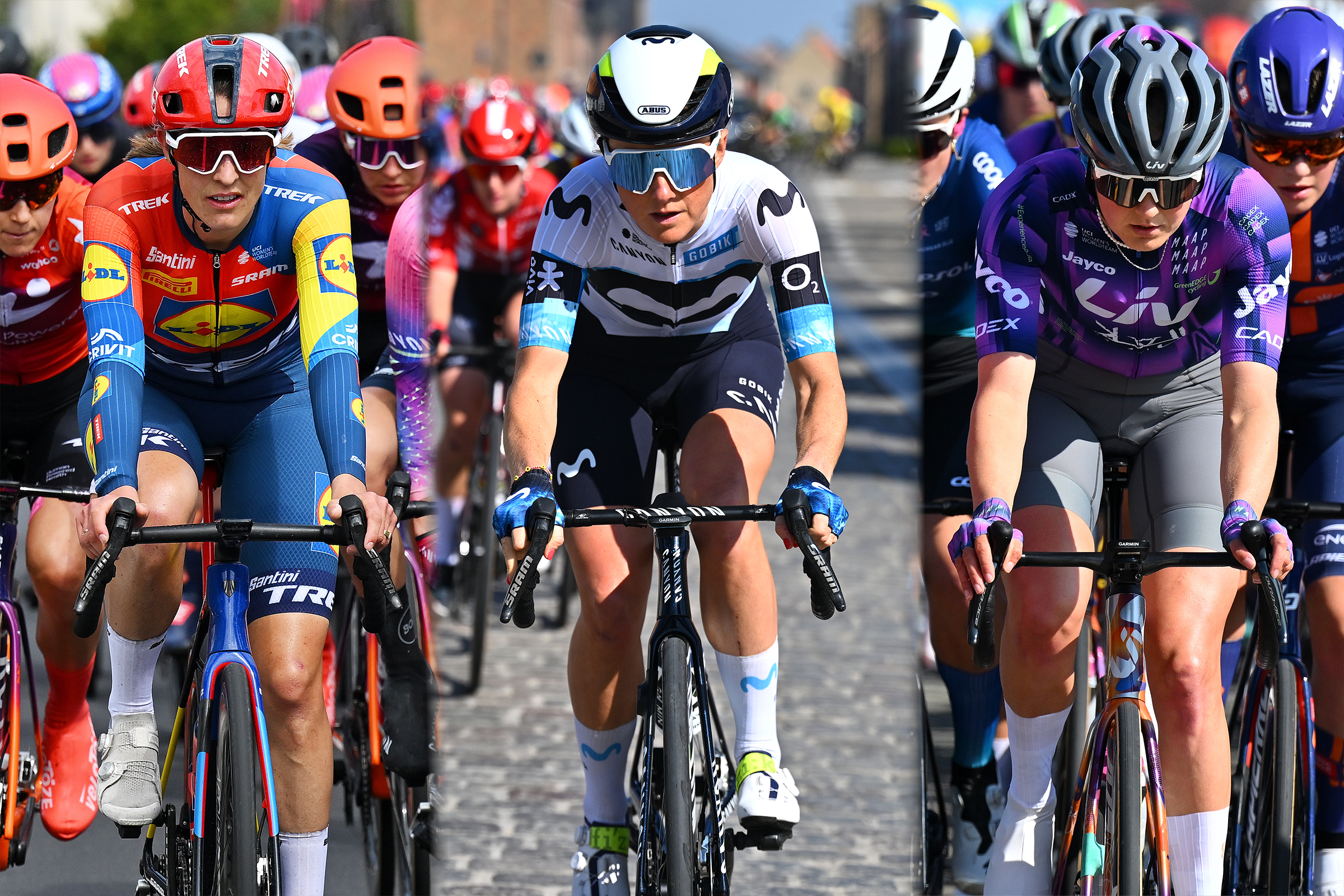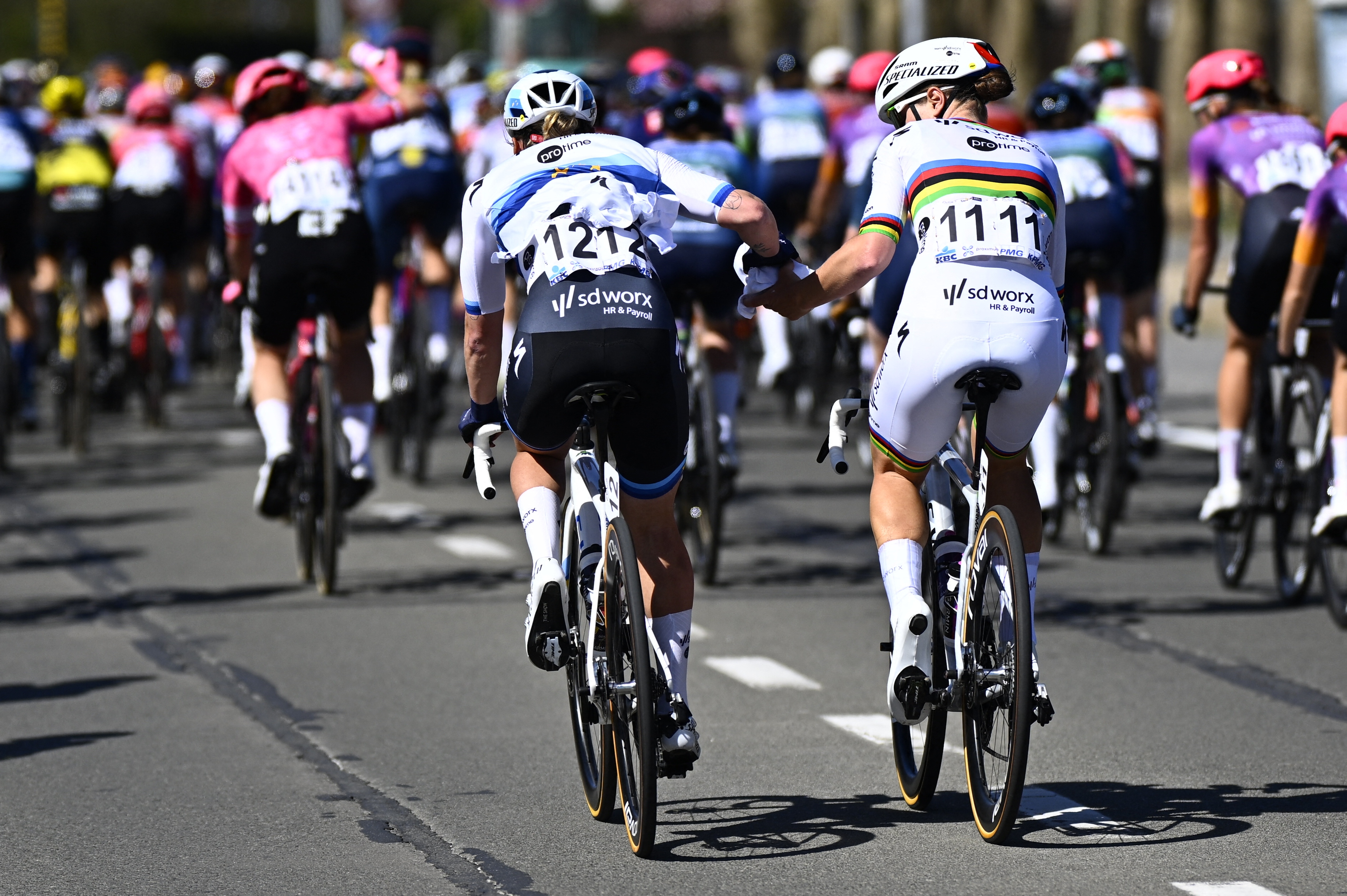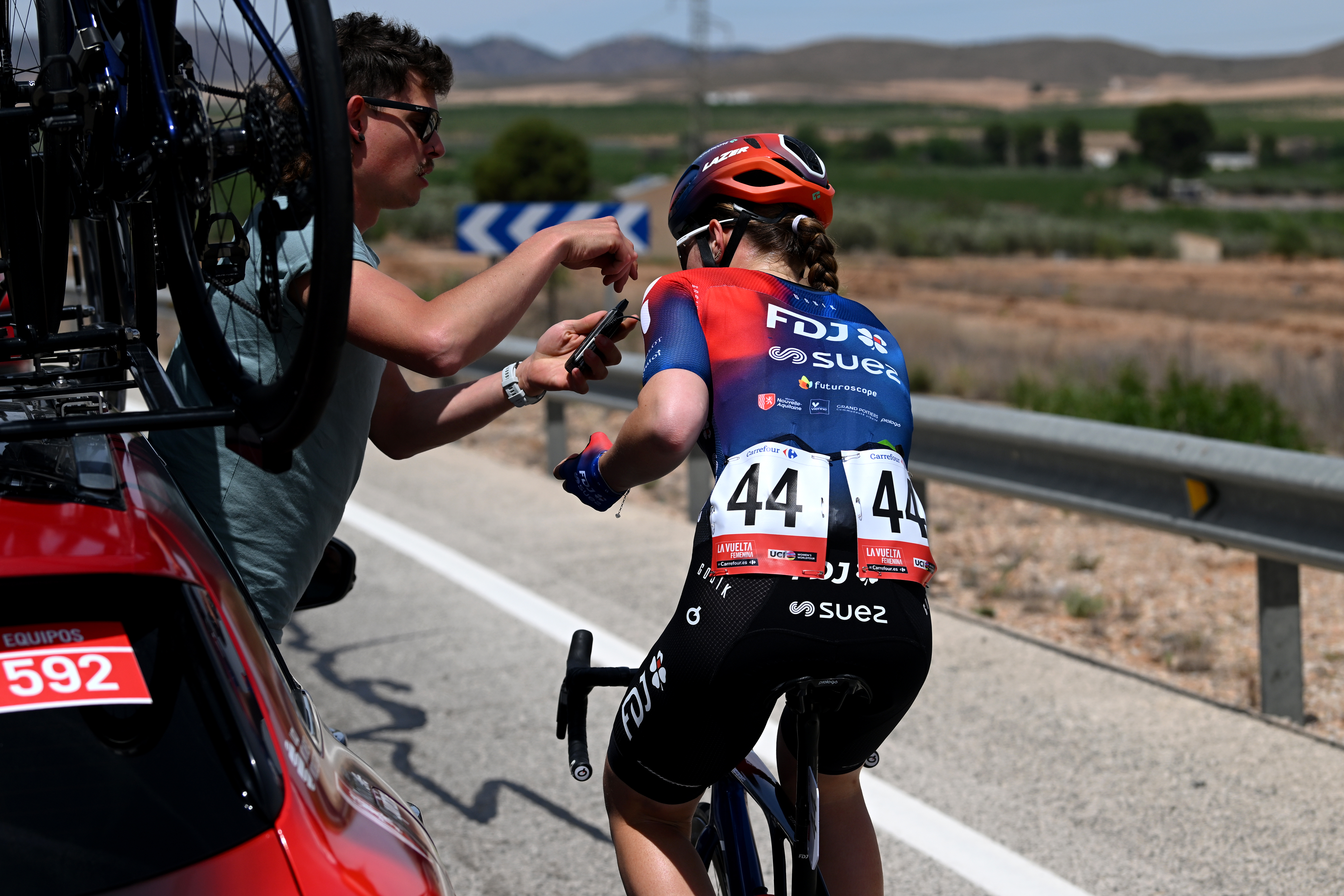
The road captain. It's a notion we're familiar with in men's cycling, and you could probably name a few riders who have made a name for themselves in that role during their careers: Luke Rowe, Bernie Eisel, Tony Gallopin. These are riders whose tactical prowess is on par with their sports director – it's no wonder many of them take on that role post-racing – and they're trusted to make decisions on the road, read the race, and make the plan.
But what about in women's cycling? The dynamic of women's cycling has been and still is very different from the men's peloton, for a multitude of reasons, but as the importance of structured teams and highly tactical racing has grown, so has the prevalence of riders clearly defined as their team's captain.
There may be a slight misconception that it's the team cars and directors who are shaping the racing, but in reality, most of the big decisions are made on the road, and it takes a particular kind of character and rider to be able to do that.
During the recent Spring Classics, where good tactics and quick decision-making are more important than anywhere else, Cyclingnews endeavoured to get to know some of the most important women in the peloton, the road captains.
Who are the road captains, and what does it take to be one?
The first question to answer was, who are the riders taking on this role in the peloton? In some teams, it was exactly as you'd expect: at Lidl-Trek, Lucinda Brand leads on the road, with a healthy dose of input from Ellen van Dijk. At Movistar, the experienced Floortje Mackaij acts as a mentor to their newly put-together squad. For Canyon-SRAM zondacrypto, it's a role Tiffany Cromwell fits into in the later part of her career.
At other teams, the road captains are a little less obvious: the unassuming Jeanne Korevaar leads Liv AlUla Jayco with a calm authority, and at AG Insurance-Soudal you maybe wouldn't assume that 22-year-old Ilse Pluimers is the one taking up the leadership mantle.
It's also important to say that it's not a hard-and-fast rule that a team has one particular figurehead, and plenty of teams will do it differently. At SD Worx-Protime, for example, Elena Cecchini is often called their road captain, but in reality, Lotte Kopecky and Lorena Wiebes will often lead from the front in the key parts of races. At a team like Fenix-Deceuninck, decision-making is encouraged to be a collective thing, not just handed down from one rider. Less experienced teams may lean on the director more, whilst more established ones know how to plan and communicate on the road.
In those teams where there is a clear captain, what sets those riders apart? There are a few clear things: experience and tactical intelligence are two clear ones, but things like having a good communication style or a positive, unifying attitude are also important.
"I think tactically I'm quite good, so that makes sense for this role," Jeanne Korevaar told Cyclingnews at the Classics. "I've done these races already a lot of times, so it's really nice that I can share that experience with the girls."
In a team like Lidl-Trek, where – in the Classics, at least – the whole team is very experienced, what makes a rider stand out is their ability to really read a race, and take the final decision in a team where every rider may have a view.
"Our race captain is Lucinda Brand, but of course I'm also saying what I'm thinking and we are always in contact together," her teammate Ellen van Dijk said. "I'm one of the people who says stuff, but not the only one for sure.
"Lucinda is somebody who always has a good overview of things, so she's a really good race captain."

Lucinda Brand is often seen leading the charge for Lidl-Trek
For a rider like Romy Kasper, Human Powered Health's captain, the role is mainly about racing nous, and leading the tactical plan.
“It’s about ensuring that we are positioned well at crucial points and have everything under control," she said. "This means knowing who is in the breakaway, if the break is dangerous, and knowing whether it is up to us to chase the break.”
In some teams, especially when rosters are not quite as established or haven't worked together as long, keeping the morale and team spirit high and the riders connected off the bike is just as important as the tactics.
"In most races I'm the captain, trying in and out of the races to keep the team together and try to have us all facing in the same direction, I like it," Floortje Mackaij said, leading Movistar's Classics team that is very much still gelling. A pro since 2014, Mackaij is a clear pick for the captain role.
Though many of the road captains are older, more experienced riders, that's not a prerequisite, and you'll find plenty of young but strongheaded riders stepping up to the role. At AG Insurance-Soudal, a team born out of an U23 squad, it's 22-year-old Ilse Pluimers who leads the team on the road.
Though young, the Dutchwoman is a very experienced racer, and a strong one, with a calm and intelligent mind. More importantly, though, Pluimers ticks the other box needed to be a road captain: a tactical affinity with her director. Sports directors don't just look for a rider who's intelligent, but one who they trust to make the decision they would.
"We feel like we think the same in the race, so whatever I say in the radio, she also thinks it and she says it to the girls, so that's really helpful," AG Insurance DS Jolien D'hoore said. "She's still very young, but she's so experienced so she knows what to do. We always need Ilse in these kinds of races."
Leadership styles
You may be reading this with an idea in your head of how a road captain actually sets about doing their job, maybe it's shouting orders in the peloton, maybe it's relaying things through the radio, or maybe it's just racing by example. In reality, there's no set way to do it, and different personalities will take different approaches.
Of course, being a strong communicator is a key element of the role, but that can come in many different forms. As Van Dijk said, she and Brand will be talking a lot, both with each other, the team and the directors, and really calling the shots out loud in the bunch. Watch any race and you'll see plenty of riders talking, shouting, putting an arm round one another to share some encouragement.
For other riders, though, constant dialogue is not necessarily needed, like for Jeanne Korevaar, who is always in control but in a calm and collected way.
"I'm not really talking all the time," the Liv AlUla Jayco rider said. "I think everyone knows what to do, if everything goes to plan, but I think it's most important to make the decisions when things are changing, or on days like today [Gent-Wevelgem] with the wind, I really make sure all the girls know when to be there."
In other teams, communication can even be completely non-verbal – shouting out in the peloton is not for everyone.
"Certain riders will touch you in the bunch, and I sometimes use that, because I find it a bit harder to use my voice sometimes when I'm in a stressful moment," Human Powered Health's Ruth Edwards said, who counts on Romy Kasper as her road captain.
"So even just a small form of communication like a small touch, so my teammates know it's me behind them instead of yelling 'Ruth back! Ruth behind you!'. Sometimes I don't find that I can get those words out."

Taking a moment to physically check-in amidst the racing chaos can also be important
For Kasper, whose role is often about positioning and leading out, that captaincy is often a largely physical task, literally guiding her teammates into the right spot.
“[I make] the first call to get it started and, until the sprinter takes over, guiding the ‘train’ towards the finish," she said. "If we lose each other then I will guide the sprinter back on a teammate’s wheel or try to bring her to the wheel of one of the main sprinters.”
So whilst there are lots of similarities across the riders who wear the metaphorical road captain's badge, it's not a cookie-cutter set of characteristics, and leadership will look different from team to team.
Who makes the decisions, and how much comes from the team car?
In recent months and through the Spring Classics, occasionally perplexing tactics have played out in some of the big women's races, and it's often been the directors that have drawn criticism for perceived tactical errors like what happened at Omloop Het Nieuwsblad earlier in the year, where the peloton failed to work together to bring back the breakaway.
But in reality, how much of the tactics on the road are coming from the car? The race director is the one that will stand up at the front of the bus on the morning of a race and explain the plan and the ideal tactics, but when the race is kicking off right in front of you, it's the riders that decide what to do, not a director in a car.
"In the car, they can tell us a lot, but in the end, the rider has to make a split-second decision," Korevaar. "Especially today [Gent-Wevelgem] with the wind, everyone will know the points when to go. But, for example, when we don't make it or when all the girls are in it, it's my decision if we will ride or not ride, or something like that."
Rather than instruction, what comes from the team is guidance, and you'll hear riders praise how well their DS's guided them, but that's often more on a practical level than relaying a tactical plan on the go.
"A lot of the time with the car, it's purely guidance of what's happening, what's coming up, or what's going on between your teammates," Edwards said.
There are also technical reasons why teams need good road captains rather than relying on radios and race directors.
"Because the radios can be a little unreliable with transmitting information, particularly from the rider to the car because of the wind noise or if you're on a descent and you can't use your hand to press the button," Edwards said.

Radios can be unreliable, or break entirely
"[As a director] you never know exactly what's happening, and we're on a delay in the car so we can never see the live action," D'hoore added. "So you need riders who can make a call in the heat of the moment, because if they're waiting for the car, it's too late."
Like the communication styles, though, that can also change from team to team, and some riders will look more to their DS to make calls within the race.
"I think it's really a balance," Mackaij said about the decision-making between the riders and the car. "Kelvin Dekker, our DS mostly in the spring, is really good at making decisions, and I just need to see how things go in the real split moments."
For most DS's, though, the important thing is just that the riders do make a decision, any decision, and many directors – especially of younger teams – are really trying to empower and encourage their riders to do that.
"The main thing is that they're not afraid to make decisions by themselves," Fenix-Deceuninck DS Michel Cornelisse told us. "Because you make a tactical [plan], but like in Gent-Wevelgem, we lost Marthe Truyen already early, and she was important in the plan, so they also must be smart enough to say 'okay, we have a problem, so now we're going to do it like this'.
"Of course, I try to help them a little bit from the car, but it's also not bad if they think for themselves. I always say to do something with the plan to win, and then after the race, it's easy for me to say if it was good or bad, but I like when they do something with the plan to win. Winning is not easy; you have 25 teams, and only one team goes home with the win. So I like when they start thinking for themselves."
With the dynamic in the women's peloton totally changing in 2025, and the focus on tactical, deliberate racing becoming more and more important each year, the role of the road captain is only going to become more crucial in the peloton. You may not be as familiar with the women's peloton's figureheads just yet, but these are the people who are really shaping the racing in key moments, so it's time to get to know them.







